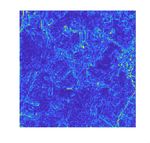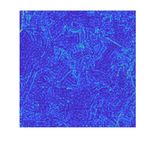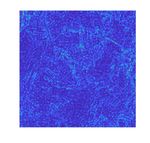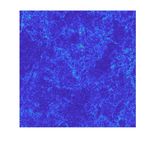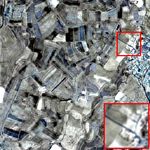PAN-SHARPENING VIA HIGH-PASS MODIFICATION CONVOLUTIONAL NEURAL NETWORK
←
→
Page content transcription
If your browser does not render page correctly, please read the page content below
PAN-SHARPENING VIA HIGH-PASS MODIFICATION CONVOLUTIONAL NEURAL NETWORK Jiaming Wang 1 , Zhenfeng Shao 1 , Xiao Huang 2 , Tao Lu 3 , Ruiqian Zhang 1 , Jiayi Ma 4 1 State Key Laboratory for Information Engineering in Surveying, Mapping and Remote Sensing, Wuhan University 2 Department of Geosciences, University of Arkansas arXiv:2105.11576v1 [cs.CV] 24 May 2021 3 Hubei Key Laboratory of Intelligent Robot, School of Computer Science and Engineering, Wuhan Institute of Technology, 4 the Electronic Information School, Wuhan University ABSTRACT generating HR-MS images, thus breaking the technological Most existing deep learning-based pan-sharpening methods limits. Therefore, pan-sharpening tasks can be regarded as a have several widely recognized issues, such as spectral distor- crucial pre-processing step for numerous remote sensing data tion and insufficient spatial texture enhancement, we propose applications [2]. a novel pan-sharpening convolutional neural network based Over the past few decades, many different pan-sharpening on a high-pass modification block. Different from existing algorithms have been proposed. Traditional pan-sharpening methods, the proposed block is designed to learn the high- methods can be divided into three main categories: compo- pass information, leading to enhance spatial information in nent substitution (CS)-, multi-resolution analysis (MRA)-, each band of the multi-spectral-resolution images. To facil- and variational optimization (VO)-based methods [3]. CS- itate the generation of visually appealing pan-sharpened im- based methods aim to separate the spatial and spectral in- ages, we propose a perceptual loss function and further op- formation of the MS images in a suitable space and fur- timize the model based on high-level features in the near- ther fuse them with the corresponding PAN images. The infrared space. Experiments demonstrate the superior per- representative CS-based methods include the Intensity-Hue- formance of the proposed method compared to the state-of- Saturation (IHS) methods, the principal component analysis the-art pan-sharpening methods, both quantitatively and qual- (PCA) methods, and the Gram-Schmidt (GS) methods [4]. In itatively. The proposed model is open-sourced at https: comparison, MRA-based methods decompose MS and PAN //github.com/jiaming-wang/HMB. images into the multi-scale space via the utilization of the Laplacian pyramid transform and the Wavelet transform. The Index Terms— Residual enhancement, pan-sharpening, decomposed PAN images are injected into the corresponding image fusion, deep neural networks MS images for information fusion [5]. VO-based methods 1. INTRODUCTION regard the pan-sharpening tasks as an ill-posed problem [6] with the goal of loss minimization. Li et al. [7] first proposed With the rapid development of satellite sensors, remote sens- a sparse-representation pan-sharpening method that recon- ing images have become widely used in various academic structed the HR-MS images using similar image patches of fields and in both civil and military domains. However, as the dictionary in the PAN space. Further, Cheng et al. [8] recognized by many, remote sensing sensors own the intrinsic adopted a two-step learning strategy with improved represen- trade-off between the spatial resolution and spectral resolu- tation ability. Following the above pioneering works, various tion [1]. As a result, for a certain remote sensing sensor, the regularization terms were introduced to the representation captured gray panchromatic (PAN) images are generally with coefficient optimization. However, the performance of these a finer resolution than multispectral (MS) images. Typically, traditional methods is limited due to the models’ shallow the goal of pan-sharpening is to integrate the texture details nonlinear expression ability. of the high-resolution (HR) PAN images and the spectral in- formation low-resolution (LR) MS images for the purpose of Recently, several convolutional neural networks-based (CNN) pan-sharpening algorithms have been proposed, ben- This work was supported in part by the National Key R&D Program efiting from the powerful feature extraction capability of of China under Grant 2018YFB0505401; in part by the National Natural Sci- ence Foundation of China under Grants 41890820, 41771452, 41771454, and CNN and the development of deep learning-based single- 62072350; in part by the Key R&D Program of Yunnan Province in China image super-resolution techniques that recover the missing under Grant 2018IB023. high-frequency information from the LR image. Inspired by
the super-resolution CNN (SRCNN) [9], PNN [10] learned where HHM B (.) refers to the proposed high-pass modifica-
the nonlinear mapping function from the concatenation of tion block (HMB). f1 (.) and f2 (.) denote the CNN-based fea-
the LR-MS and PAN to the HR-MS image. Scarpa et al. ture extractor. IP AN ↓2 denotes the down-sampling version of
[11] proposed a target-adaptive CNN-based framework that IP AN with scale factor × 2 via a bicubic interpolation func-
learned the residual image with improved performance over tion. IF used and IF used↑2 are the fused HR-MS image (scale
image fusion tasks. Multi-scale and multi-depth CNN (MS- factor × 4) and the fused HR-MS image (scale factor × 2),
DCNN) [12] was proposed to extract multi-scale features. respectively.
Han et al. [13] proposed a surface- and deep-level constraint-
based pan-sharpening network. Cai et al. [2] proposed a
Up-Block
Up-Block
Res
Res
Res
Res
…
…
super-resolution guided progressive pan-sharpening CNN,
achieving better performance by combining multi-scale fea- LRMS Fused ↑2 Fused
tures.
HMB
HMB
Despite the first-rate results these CNN-based methods
can obtain, some problems remain to be solved. As most PAN↓2 PAN
of these methods are inspired by the concept of single-image ↑2
Residual Block (Res)
super-resolution that generates an HR image from the corre- High-pass Modification
Res
Res
…
HMB Block (HMB)
sponding LR one, they fail to make full use of the rich high- Up-sampleing
Up-Block
frequency spatial information from HR-PAN images. Some
methods [14, 2] treat the PAN image as the missing high-
Fig. 1. The overall structure of the proposed HMCNN. ⊕
frequency information of the MS image, nevertheless leading
denotes element-wise sum.
to spectral distortion [14]. To address these problems, we pro-
posed a novel pan-sharpening method based on a high-pass 2.2. The High-pass Modification Block (HMB)
modification block, termed HMCNN. The main contributions
of the proposed method are: Pan-sharpening belongs to an ill-posed problem, which em-
ploys additional prior from PAN images for the reconstruc-
1. We design a high-pass modification block to enhance tion. Traditional approaches [14, 2] try to exploit the high-
the spatial information in each band of the MS image. frequency information as a residual map. As for the MS im-
The corrected residual image can fully exploit the spa- age enhancement problem, it is crucial to effectively exploit
tial prior of the PAN images, largely avoiding the prob- the intrinsic relations between the PAN images and all bands
lem of spectral distortion. of the MS image. Inspired by Zhang et al. [15], we intro-
duce a spatial attention mechanism to adaptively rescale each
2. We use a perceptual loss to constrain the model in the pixel-wise feature, thus improving the representation ability
near-infrared (NIR) band. These feature maps in the of the spatial residual information .
perceptual domain play an essential role in the detail The proposed high-pass modification block (Fig. 2),
enhancement of texture information. termed HMB, is designed to exploit the high-frequency prior.
2. METHOD In particular, HMB cascade n (n = 11) residual blocks with
3 × 3 convolutions.
2.1. Problem Formulation
Fig. 1 presents the flowchart of the proposed HMCNN. We FX,1 = fR (concat(X, P )), (3)
intent to super-resolve the input LR-MS with a multi-scale
where concat(.) refers to the concatenation function and
framework to alleviate the burden of computing resources.
fR (.) denotes the residul network. X denotes the band in the
We denote the LR-MS image as ILRM S of size w × h × c and
MS image (X ∈ {R, G, B, N }, N is NIR). We further feed
the corresponding HR-PAN image as IP AN of size sw ×sh×
FX,1 into a spatial attention block,
1, and the ground truth HR-MS IHRM S of size sw × sh × c ,
where w and h represent the width and height of the LR-MS Pb = P − D(P ), (4)
image, respectively. c is the number of image bands in the
MS image, and s denotes the spatial resolution scale between X
b = (fSA (FX,1 ) + 1)Pb, (5)
ILRM S and IP AN . Our goal is to generate the HR-MS image
IF used from the input HR-PAN image IP AN and the LR-MS where D(.) is the bicubic upsampling operation and Pb refers
image ILRM S via an end-to-end solution, to the high-pass version (residual information) of the PAN
image. fSA (.) denotes the function of the spatial attention
IF used↑2 = f1 (ILRM S ) + fHM B (f1 (ILRM S ), IP AN ↓2 ), module. X b denotes the high-pass version of X in the MS
(1) image. We obtain the output of the current HMB by
IF used = f2 (ILRM S↑2 ) + fHM B (f2 (ILRM S↑2 ), IP AN ),
(2) M
c = concat(R,
b G,
b B,
b Nb ), (6)where Mc denotes the high-pass version of the MS image that where α is used to balance the contributions of different is used for the reconstruction. losses. In our experiments, we set α as a constant: α = 1e−3. R 3. EXPERIMENTS … ! R P 3.1. Dataset and Implementation Details ! P sharing Weight ! … … M We conduct experiments on the WordView II (WV) dataset. … ! N The spatial resolution of PAN images in the dataset is 0.5 m … ! N P with a spatial resolution ratio of 4 (s = 4) between PAN and ! P LR-MS images. We crop the HR-MS images (the original P element-wise sum element-wise multiplication MS) into image patches of size 256 × 256 × 4 pixels and the High-pass concatenation convolution PReLU Spatial Attention PAN images (the downsampled version of original PAN with ! P the scale factor ×4) into image patches of size 256 × 256 × 1 pixels. Then, the downsampled LR-MS image patches are Fig. 2. The architecture of high-pass modification block. with a size of 64 × 64 × 4 pixels. The proposed model is trained with a batch size 12 of `2 . 2.3. The Loss Function Adam optimizer is used to optimize the proposed model with β1 = 0.9, β2 = 0.999, and ε = 1e − 8. The learning rate Existing pan-sharpening methods generally take pixel-wise is initialized to 1e − 4, and decreases by a factor of 10 for error as the loss function for higher objective assessment re- every 1,000 epochs. The training stops at 2,000 epochs. We sults. Among them, mean square error (MSE) and mean ab- use PyTorch on a desktop with Ubuntu 18.04, CUDA 10.2, solute error (MAE) are the two most widely used loss func- CUDNN 7.5, and Nvidia TAITAN RTX GPUs. tions. Specifically, the `2 loss is defined as the MSE between Eight widely used metrics of image quality assessment the HR-MS and ground truth: are employed to evaluate the performance, including erreur relative dimensionless global error in synthesis (ERGAS), N 1 X m root mean square error (RMSE), root mean absolute error L1 (θ) = kI − IFmused k2 , (7) (RMAE), spectral angle mapper (SAM), a universal image M m=1 HRM S quality index (UIQI), the spectral distortion index Dλ , the where IFmused is the m-th fused HR-MS. M denotes the num- spatial distortion index DS , and the quality without reference ber of images in a training batch. θ denotes the parameters in (QNR). The best values for these metrics are 0, 0, 0, 0, 1, HMCNN. 0, 0, and 1, respectively. Among the above metrics, the last Although pixel-wise loss functions can achieve results three metrics (i.e., Dλ , DS , QNR) are no-reference image with higher objective evaluations, they tend to generate over- quality assessment. For RMAE, RMSE, and UIQI of the smoothed images and often fail to capture perceptual differ- pan-sharpening images, we report their mean values of all ences (e.g., information regarding the textures and edges). bands. Inspired by the VGG-based feature-wise loss function in SR 3.2. Comparison with State-of-The-Art Methods tasks, we propose a novel perceptual loss (NIR-VGG) for texture enhancement, specifically targeting the NIR band. To verify the effectiveness of the HMCNN, eight state-of-the- Different from the natural images scene, the spectral wave- art pan-sharpening algorithms are selected for the compari- length of the NIR band of MS images is larger than other son: IHS [16], GS [4], Brovey [17], SFIM [18], PNN [10], bands, thus providing abundant texture information. Specifi- PANNet [19], MSDCNN [12], and SRPPNN [2]. cally, the NIR-VGG loss minimizes the feature-wise error in In Table 1, we report the quantitative evaluation results the NIR space, of the these architectures over the aforementioned evalua- tion metrics, where the number highlighted by red represents 1 X N the best result in each evaluation metric and the blue repre- LN N (θ) = kφ(N IR(IFn used )) sents the second best. We observe that HMCNN surpasses N n=1 (8) SRPPNN in all the indices. Quantitative evaluation (Fig. 3) n −φ(N IR(IHRM S ))k2 , also proves the superiority of our method. Images in the last row of Fig. 3 are the MSE between the pan-sharpened where N IR(.) denotes the NIR band of an image and φ(.) is results and the ground truth. By comparing pan-sharpened the output feature maps of the pre-trained VGG-19 network. images with the ground truth, we observe that traditional LN N indicates the loss bwtween HR-MS and fused images in algorithms perform poorly with noticeable artifacts. The pan- the NIR band space. The final objective loss is simply com- sharped images using HMCNN and SRPPNN are similar to puted by the ground truth comparing with other deep learning based Ltotal (θ) = αLN N (θ) + L1 (θ), (9) methods , evidenced by their error maps. In the zoomed area
Table 1. Comparison of pan-sharpening performance among the HMCNN and eight other state-of-the-art methods on the WV dataset. Best and second-best results are highlighted by red and blue, respectively. Methods ERGAS ↓ RMSE ↓ RMAE ↓ SAM ↓ UIQI ↑ Dλ ↓ DS ↓ QNR ↑ IHS [16] 2.0743 4.7351 8.2615 2.6611 0.5540 0.0774 0.2059 0.7337 GS [4] 1.9827 4.7200 8.2133 2.5514 0.6070 0.0387 0.1536 0.8147 Brovey [17] 1.8615 4.4840 7.8146 2.2997 0.6017 0.0629 0.1706 0.7780 SFIM [18] 2.5265 5.6198 9.7548 2.5775 0.5897 0.0842 0.1407 0.7875 PNN [10] 1.9399 4.4261 7.7268 2.5682 0.5875 0.0321 0.0790 0.8915 PANNet [11] 1.3243 3.2157 5.6180 1.9270 0.6700 0.0396 0.1072 0.8575 MSDCNN [12] 1.3847 3.2541 5.6762 1.8307 0.6903 0.0407 0.0919 0.8713 SRPPNN [2] 1.2061 2.8147 4.9074 1.5292 0.7198 0.0187 0.0720 0.9107 HMCNN(our) 1.0033 2.6027 4.5377 1.4244 0.7513 0.0163 0.0698 0.9150 Ground Truth PNN PANNet MSDCNN SRPPNN HMCNN(our) (highlighted using red rectangles in Fig. 3), HMCNN suc- cessfully preserves the rich texture information of land and Image ditches. Classification LRMS PAN IHS GS Brovey SFIM Fig. 4. Pan-sharpened images (the first row) and the classifi- cation results using the ISODATA classification method (the second row). The boxes highlight the differences among var- PNN PANNet MSDCNN SRPPNN HMCNN(our) Ground Truth ious approaches and emphasize the superiority of HMCNN. IHS GS Brovey SFIM PNN PANNet MSDCNN SRPPNN HMCNN(our) ity. In HMCNN, despite its improved performance, the two high-pass modification blocks demand more computational Fig. 3. Qualitative comparison of HMCNN with eight com- resources. parative algorithms on a typical satellite image pair from the WV dataset. Images in the last row row represent the MSE between the pan-sharpened images and the ground truth. We employ ISODATA, a classical unsupervised seman- tic segmentation using an iterative self-organizing techniques, to evaluate the results of different deep learning based pan- sharpening methods. The number of classifications in the ISODATA is set to five. We set the maximum iteration to five times. Fig. 4 shows the pan-sharpened (the first row) and clas- Fig. 5. The mean running time for the proposed HMCNN and sification results using ISODATA (the second row) with the other deep learning-based methods. boxes highlighting the differences among various approaches and emphasizing the superiority of HMCNN. We observe that 4. CONCLUSION PNN tends to generate blurred pan-sharpened images, thus preventing a fine classification result. The classification re- In this article, we propose a high-pass modification block, sult of HMCNN includes considerably more accurate details termed HMB, for pan-sharpening. We first design the HMB and is visually the closest to the ground truth. to enhance the high-frequency information in the different 3.3. Running Time Analysis bands of the MS images, aiming to restore the rich and de- tailed information. To further generate visually appealing Finally, we investigate the efficiency of HMCNN compared pan-sharpened images, we introduce a perceptual loss func- with other deep learning base approaches. The results are tion that targets near-infrared space. The results suggest that shown in Fig. 5. We notice that SRPPNN and our proposed the proposed perceptual loss function is able to obtain fine method require considerably longer processing time than oth- details and sharp edges. Through experiments and ablation ers. For SRPPNN, we believe its dense feature maps and studies, the proposed method exhibits state-of-the-art perfor- convolution blocks are responsible for the increased complex- mance.
5. REFERENCES [12] Qiangqiang Yuan, Yancong Wei, Xiangchao Meng, Huanfeng Shen, and Liangpei Zhang, “A multiscale [1] Huanfeng Shen, Xiangchao Meng, and Liangpei Zhang, and multidepth convolutional neural network for remote “An integrated framework for the spatio–temporal– sensing imagery pan-sharpening,” IEEE Journal of Se- spectral fusion of remote sensing images,” IEEE trans. lected Topics in Applied Earth Observations and Remote on Geoscience and Remote Sensing, vol. 54, no. 12, pp. Sensing, vol. 11, no. 3, pp. 978–989, 2018. 7135–7148, 2016. [13] Han Xu, Jiayi Ma, Zhenfeng Shao, Hao Zhang, Junjun [2] Jiajun Cai and Bo Huang, “Super-resolution-guided Jiang, and Xiaojie Guo, “Sdpnet: A deep network for progressive pansharpening based on a deep convolu- pan-sharpening with enhanced information representa- tional neural network,” IEEE trans. on Geoscience and tion,” IEEE trans. on Geoscience and Remote Sensing, Remote Sensing, 2020. 2020. [3] Xiangchao Meng, Huanfeng Shen, Huifang Li, Liangpei [14] Menghui Jiang, Huanfeng Shen, Jie Li, Qiangqiang Zhang, and Randi Fu, “Review of the pansharpening Yuan, and Liangpei Zhang, “A differential information methods for remote sensing images based on the idea residual convolutional neural network for pansharpen- of meta-analysis: Practical discussion and challenges,” ing,” ISPRS Journal of Photogrammetry and Remote Information Fusion, vol. 46, pp. 102–113, 2019. Sensing, vol. 163, pp. 257–271, 2020. [4] Craig A Laben and Bernard V Brower, “Process for en- [15] Yulun Zhang, Kunpeng Li, Kai Li, Lichen Wang, Bi- hancing the spatial resolution of multispectral imagery neng Zhong, and Yun Fu, “Image super-resolution us- using pan-sharpening,” 2000, US Patent 6,011,875. ing very deep residual channel attention networks,” in [5] Bruno Aiazzi, Luciano Alparone, Stefano Baronti, and Proceedings of the European Conference on Computer Andrea Garzelli, “Context-driven fusion of high spatial Vision, 2018, pp. 286–301. and spectral resolution images based on oversampled [16] Wjoseph Carper, Thomasm Lillesand, and Ralphw multiresolution analysis,” IEEE trans. on geoscience Kiefer, “The use of intensity-hue-saturation transforma- and remote sensing, vol. 40, no. 10, pp. 2300–2312, tions for merging spot panchromatic and multispectral 2002. image data,” Photogrammetric Engineering and remote [6] Hussein A Aly and Gaurav Sharma, “A regular- sensing, vol. 56, no. 4, pp. 459–467, 1990. ized model-based optimization framework for pan- sharpening,” IEEE trans. on Image Processing, vol. 23, [17] Alan R Gillespie, Anne B Kahle, and Richard E Walker, no. 6, pp. 2596–2608, 2014. “Color enhancement of highly correlated images. ii. channel ratio and ”chromaticity” transformation tech- [7] Shutao Li and Bin Yang, “A new pan-sharpening niques,” Remote Sensing of Environment, vol. 22, no. method using a compressed sensing technique,” IEEE 3, pp. 343–365, 1987. trans. on Geoscience and Remote Sensing, vol. 49, no. 2, pp. 738–746, 2010. [18] JG Liu, “Smoothing filter-based intensity modulation: A spectral preserve image fusion technique for improv- [8] Ming Cheng, Cheng Wang, and Jonathan Li, “Sparse ing spatial details,” International Journal of Remote representation based pansharpening using trained dic- Sensing, vol. 21, no. 18, pp. 3461–3472, 2000. tionary,” IEEE Geoscience and Remote Sensing Letters, vol. 11, no. 1, pp. 293–297, 2013. [19] Junfeng Yang, Xueyang Fu, Yuwen Hu, Yue Huang, Xinghao Ding, and John Paisley, “Pannet: A deep net- [9] Chao Dong, Chen Change Loy, Kaiming He, and Xi- work architecture for pan-sharpening,” in Proceedings aoou Tang, “Image super-resolution using deep convo- of the IEEE International Conference on Computer Vi- lutional networks,” IEEE trans. on pattern analysis and sion, 2017, pp. 5449–5457. machine intelligence, vol. 38, no. 2, pp. 295–307, 2015. [10] Giuseppe Masi, Davide Cozzolino, Luisa Verdoliva, and Giuseppe Scarpa, “Pansharpening by convolutional neu- ral networks,” Remote Sensing, vol. 8, no. 7, pp. 594, 2016. [11] Giuseppe Scarpa, Sergio Vitale, and Davide Cozzolino, “Target-adaptive cnn-based pansharpening,” IEEE trans. on Geoscience and Remote Sensing, vol. 56, no. 9, pp. 5443–5457, 2018.
You can also read





